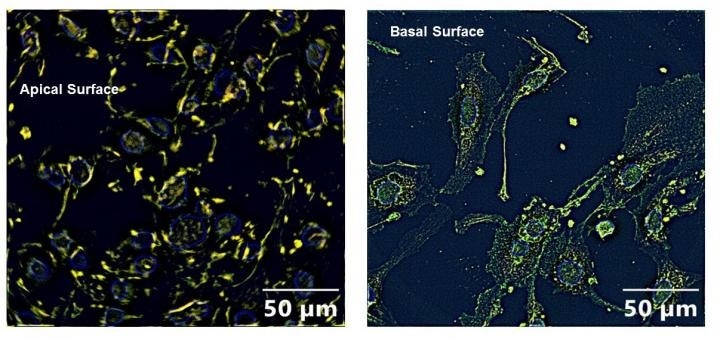Apr 27 2021
Researchers have performed a new study in human lung airway cells, which is one of the first to demonstrate a possible connection between increased vulnerability to COVID-19 infection and exposure to organophosphate pesticides.

ACE2 (yellow), the receptor for COVID-19, was more highly expressed in the apical surface (left) when lung epithelial cells were exposed to organophosphates and IL-6. The right image shows less ACE2 expression on the basal surface. Apical surface expression causes more virus to attach to the ACE2 receptor. Image Credit: Saurabh Chatterjee, PhD, University of South Carolina.
The study results could have implications for veterans, several of whom were exposed to organophosphate pesticides at the time of wars.
Exposure to organophosphate pesticides is considered to be one of the potential causes of Gulf War Illness, a bunch of medically inexplicable chronic symptoms including headaches, fatigue, dizziness, joint pain, insomnia, indigestion, memory problems, and respiratory disorders. Over 25% of Gulf War veterans are predicted to experience this condition.
We have identified a basic mechanism linked with inflammation that could increase susceptibility to COVID-19 infection among people exposed to organophosphates. This mechanism could also increase risk for people with metabolic diseases and cancer because they tend to exhibit the same type of inflammation.”
Saurabh Chatterjee, PhD, University of South Carolina
Chatterjee is the leader of the research team and also a research health specialist at the Columbia VA Medical Center.
Ayan Mondal, Ph.D., a postdoctoral fellow in Chatterjee’s lab, will present the study at the American Society for Biochemistry and Molecular Biology annual meeting as part of the virtual Experimental Biology (EB) 2021 meeting, scheduled from April 27th to 30th, 2021.
The reason why COVID-19 causes a severe form of disease leading to hospitalization and high rates of mortality in a small segment of society is unclear. This work sheds new light on exposure to pesticides and potential susceptibility to COVID-19 through altered immune response.”
Prakash Nagarkatti, Study Co-Author and Vice President for Research, University of South Carolina
In an earlier study, the researchers identified increased interleukin 6 (IL-6) levels in a mouse model of Gulf War Illness and samples from veterans. The body generates these pro-inflammatory proteins to fight infections and react to tissue injuries. But continuous production of IL-6 can result in chronic inflammation and has been demonstrated to decrease the immune system’s response to viruses.
As part of the new study, the researchers intended to identify whether exposure to the organophosphate pesticide chlorpyriphos and higher levels of IL-6 could increase the risk of SARS-CoV-2 infection. Human lung airway epithelial cells were exposed to either IL-6 or chlorpyriphos or both in combination, for 6 hours. As a control group, another group of cells received no exposure.
Then, the researchers treated the cells with the spike proteins found outside the SARS-CoV-2—the virus responsible for COVID-19. During infection, spike proteins get attached to angiotensin-converting enzyme 2 (ACE2) receptors in the human cells, commencing a process that enables the virus to discharge its genetic material into the healthy cell.
Cells exposed to the pesticide and IL-6 were found to exhibit increased apoptosis—or regulated cell death—in the presence of the SARS-CoV-2 spike protein. The cells also exposed to both IL-6 and the pesticide exhibited considerably more ACE2 expression on the apical cell surface than unexposed cells or those exposed only to the pesticide.
The apical membrane of airway cells faces the inner side of the airway, whereas the basolateral membrane contacts the neighboring tissues. Higher ACE2 receptor expression on the apical surface indicates that more viruses will bind to the cells.
To our knowledge, this is the first study demonstrating that the ACE2 receptor translates from the basolateral cell membrane to the apical cell upon co-exposure to organophosphate and IL-6.”
Saurabh Chatterjee, PhD, University of South Carolina
“Since people with obesity, type 2 diabetes, or cancer also have high circulatory IL-6 levels, we think people with these conditions will also have increased susceptibility to SARS-CoV-2 infection because of increased translocation of ACE2 receptor to the apical cell surface,” added Chatterjee.
According to the researchers, though the findings of the study are preliminary, the study is the foundation for more animal studies that could find mechanisms of vulnerability to COVID-19 in the common population as well as in veterans exposed to organophosphates.
In the future, the researchers intend to investigate IL-6 and organophosphate exposure followed by SARS-CoV-2 spike protein administration in mice to get better insights into the immune and organ responses.